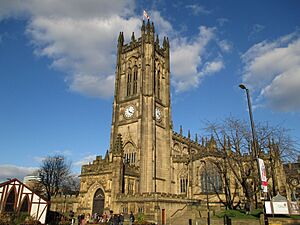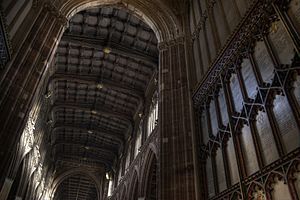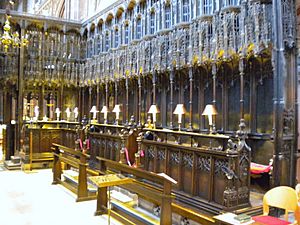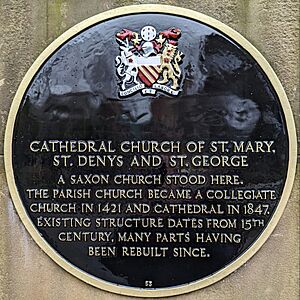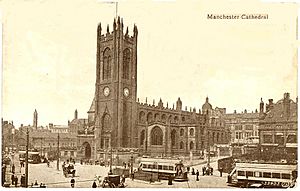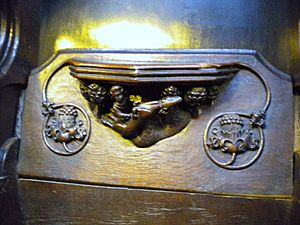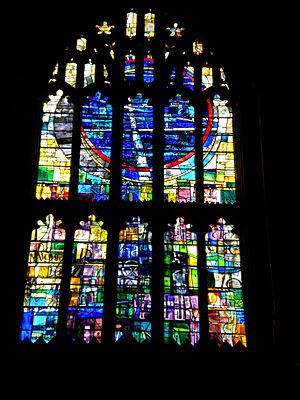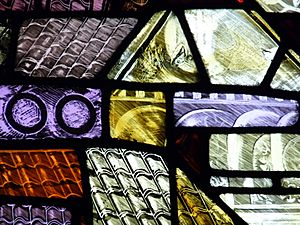Manchester Cathedral facts for kids
Quick facts for kids Manchester Cathedral |
|
|---|---|
| Cathedral and Collegiate Church of St Mary, St Denys and St George | |
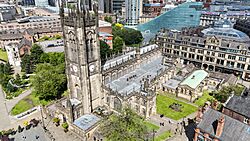
Manchester Cathedral and skyline
|
|
| Lua error in Module:Location_map at line 420: attempt to index field 'wikibase' (a nil value). | |
| Location | Victoria Street, Manchester M3 1SX |
| Country | England |
| Denomination | Church of England |
| Previous denomination | Roman Catholic |
| Tradition | Central churchmanship |
| Website | Cathedral website |
| History | |
| Status | Active |
| Architecture | |
| Functional status | Active |
| Heritage designation | Grade I listed |
| Architectural type | Gothic Revival |
| Style | Gothic (Perpendicular) |
| Years built | 1421–1882 |
| Specifications | |
| Tower height | 135ft |
| Administration | |
| Diocese | Manchester (since 1847) |
| Province | York |
Manchester Cathedral is a famous church in Manchester, England. Its full name is the Cathedral and Collegiate Church of St Mary, St Denys and St George. It is the main church for the Anglican Diocese of Manchester and the city's local church. You can find it on Victoria Street in the city centre. It is a very important building, listed as Grade I.
The church you see today was mostly rebuilt in a style called Perpendicular Gothic. This happened after a special group of priests, called a collegiate body, was formed in 1421. In the late 1400s, James Stanley II helped rebuild the main part of the church (the nave) and the choir area. He added tall windows and beautiful wooden decorations. These include the screen (pulpitum), choir stalls, and the nave roof. The roof is special because it is held up by angels playing musical instruments. In 1847, this church became the cathedral for the new Diocese of Manchester. It was repaired and made bigger many times, especially after being damaged in World War II bombings. It is one of only fifteen Grade I listed buildings in Manchester.
Contents
History of Manchester Cathedral
Early Beginnings
We don't know exactly when the first churches in Manchester were built. An old stone carving of an angel, called the Angel Stone, is kept in the cathedral. It was found in a wall and suggests there was an even older church, possibly from Anglo-Saxon times, around 700 AD. The Latin words on the stone mean "into thy hands, O Lord, I commend my spirit."
A church dedicated to St Mary was mentioned in the Domesday Book in 1086. This book was a survey of England ordered by William the Conqueror. It said that the Church of St Mary and the Church of St Michael owned land in Manchester.
Becoming a Parish Church
Building the church we know today started in 1215. It was located between the Irk and Irwell rivers. The Grelley family, who were local lords, helped build and support the first part of the church. Later, in 1311, the de la Warre family took over. In 1382, Thomas de la Warre became the church's leader.
The church was built in the Perpendicular style. It had a long main area (nave) with side aisles and a choir area.
The Collegiate Church Era
In 1421, Thomas de la Warre got permission from King Henry V and Pope Martin V to make the church a "collegiate church." This meant it would have a group of priests, called a college, living and working there. The church was dedicated to St Mary, St George (England's patron saint), and St Denys (France's patron saint). The priests lived in new buildings, which are now part of Chetham's Library.
John Huntingdon was the first leader (warden) of the college. Between 1422 and 1458, he rebuilt the eastern part of the church to create the collegiate choir. You can still see a brass plaque on the floor that remembers him.
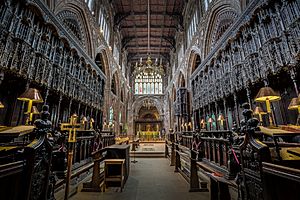
Later, James Stanley II (who was warden from 1485 to 1506) greatly rebuilt the nave and choir. He made the windows higher and added the beautiful wooden roofs and choir stalls. The Stanley family was very rich and connected to the royal family. This allowed them to hire top architects and craftspeople. The choir stalls, made by William Brownflet of Ripon, are considered some of the best in Europe. They have amazing carvings on the seats called misericords.
James Stanley also added the famous fourteen life-size angel musicians to the nave roof. Each angel plays a different instrument. He also had his own special chapel built, where he was buried in 1515.
The college was closed for a short time in 1547 but reopened in 1553. In 1578, Queen Elizabeth I gave it a new charter. The college's dedication changed to the college of Christ. John Dee, a famous scholar and astrologer for Elizabeth I, was warden from 1595 to 1608.
Side Chapels
In the early 1500s, many small chapels were built along the sides of the church. These chapels were for special prayers and memorials. They created a double aisle around the main part of the church. This makes Manchester Cathedral's nave (main area) wider than most other cathedrals in England.
Many Marriages
For a long time, until 1850, the Collegiate Church was the only place in Manchester where people could legally get married. This meant thousands of weddings happened there each year. In 1821, over 1,900 marriages took place. By 1838, there were over 2,600 weddings, along with many christenings and funerals.
Becoming a Cathedral
In 1847, the collegiate church officially became the cathedral for the new Diocese of Manchester. The building was greatly renovated in 1882.
During the Manchester Blitz in 1940, a German bomb caused severe damage to the cathedral. The roofs were badly hit, and the medieval Lady Chapel was destroyed. All the beautiful stained-glass windows were blown out. It took almost 20 years to repair everything.
The cathedral was damaged again in the IRA bombing in June 1996. After this, it was repaired once more.
The cathedral keeps many old records and historical documents, some dating back to 1421. In 2003, a project began to organize these records for the public. Manchester Cathedral was given its Grade I listed building status in January 1952. This means it is a building of "exceptional interest."
Cathedral Architecture
The cathedral is built from three types of stone. The original walls were made of dark purple-brown sandstone. Later, in the 1800s, much of the stone was replaced with buff-grey gritstone from Ramsbottom. Since the 1960s, the floors have been made of limestone from the Peak District. This limestone even contains tiny fossils!
Restorations and Repairs
By the 1840s, the cathedral's stonework was in poor condition. Many repairs and replacements were done between 1850 and 1870. The west tower was made taller in 1868. Other parts, like the vestry and library, were added later in the 1800s. Because of all these changes, the cathedral looks a lot like a 19th-century building today.
In 2013, a temporary wooden cathedral was built nearby. This allowed worship to continue while the main cathedral's heating system was upgraded.
Manchester Cathedral and World War II
Manchester Cathedral played an important role during World War II (1939–1945). It was a central place for the people of Manchester during the war. Records from the cathedral show how it helped the community during these challenging times.
Special Features and Art
Angel Minstrels
The nave roof is supported by fourteen angel sculptures. Each angel plays a different musical instrument from the late medieval period. These angels were likely a gift from James Stanley II.
- South side: Portative organ, harp, psaltery, dulcimer, lute, fiddle, hurdy-gurdy
- North side: clavicymbal, trumpet, shawm, Scots pipes, Irish pipes, recorder, tabor
These instruments were often used for popular songs and dances, or for plays performed in the streets.
Misericords
The cathedral has thirty special 16th-century misericords. These are small, carved wooden seats that choir members could lean on during long services. They are considered some of the best in Europe. One carving (N-08) is the earliest known picture of backgammon in the UK!
Stained Glass Windows
All the old Victorian stained glass windows were destroyed during the 1940 bombing. New windows were slowly added. Artist Tony Hollaway designed five important western windows, including St George (1973), St Denys (1976), and St Mary (1980). After the 1996 bombing, the Healing Window by Linda Walton was installed in 2004.
Bells
The cathedral tower has ten bells used for change ringing. They were made in 1925 and the largest bell weighs 1.3 tonnes. The bells ring for Sunday services and special events. For example, they rang when Elizabeth II visited to give out the Royal Maundy gifts.
Cathedral Leadership
As of 28 July 2024, the main leaders of Manchester Cathedral are:
- Dean — Rogers Govender
- Precentor and Sub Dean — Ian Jorysz
- Canon Missioner — Grace Thomas
- Archdeacon of Rochdale — Karen Smeeton
In Literature
The cathedral has even appeared in literature. For example, Letitia Elizabeth Landon wrote a poem called "Collegiate Church, Manchester" in 1833. It was inspired by a picture of the cathedral's inside.
Visitor Centre
A new visitor centre was opened by Elizabeth II near the cathedral's south porch. It cost £3 million and has a shop and an exhibition room. The most interesting part is the 15th-century Hanging Bridge. This bridge was once the main way to get to the church. It was buried for over 100 years before being rediscovered.
Music at the Cathedral
The Organ
The cathedral has a large organ. The original organ was destroyed in the 1940 bombing. A new one was installed in 1952. In 2016, a brand new organ was built. It is placed above the screen (pulpitum) in the church. The new organ was paid for by the Stoller foundation.
- Details of the current Tickell 'Stoller' organ
Organists
The current Organist and Master of the Choristers is Christopher Stokes. Geoffrey Woollatt is the Sub Organist. Many famous musicians have been organists here, including Frederick Bridge and Sydney Nicholson.
The Choir
Since 1421, the cathedral has had a choir of adult singers and boys. In 1969, when Chetham's School became a music school, scholarships were created for boys to sing in the cathedral choir. Later, in the 1970s, girls were also included. This made Manchester Cathedral one of the first Church of England choirs to have both boys and girls. Today, there are places for 20 young choristers and 6 adult singers.
See also
 In Spanish: Catedral de Mánchester para niños
In Spanish: Catedral de Mánchester para niños
- Grade I listed churches in Greater Manchester
- History of Manchester
- List of churches in Greater Manchester
- Listed buildings in Manchester-M3


